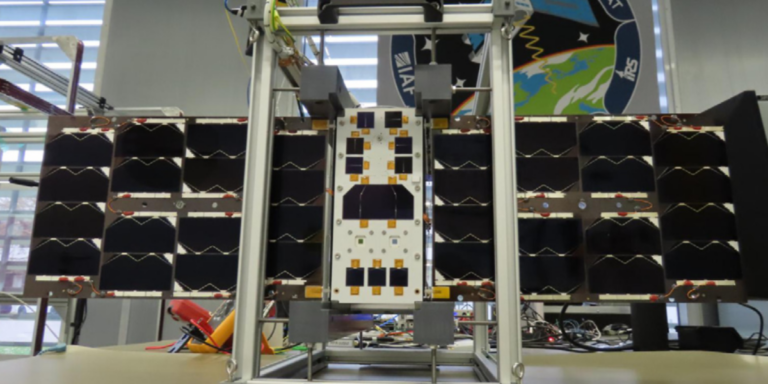A team of German researchers has developed a geminiaturized solar cell experiment for nanosatellites. It was used to test samples of new Mutlij function solar cells developed by Azur room, including new metal wrap from Triple-Junction by solar cells.
German researchers from the University of Stuttgartt and Azur Space Solar Power, the subsidiary of the cell production of Canada-in Canada-based high-purity material provider 5N Plus, conceived a Geminiaturized Solar Cell Experiment (SCE) for nanosatellites.
The SCE was used in Low Earth-Baan to measure the performance of new Triple junction Metal Wrap-Through (MWT) solar cells developed by Azur space for the new room sector in addition to four-fold solar cells.
The new instrumentation of the team successfully tasted more than 5,000 IV curves, cell temperatures, sunflout angles and total ionizing dose (TID) measurements, as described in “Design and first results of the Solar Cell Experiment on Eive“Published in Acta Astronautics.
The data collected in the track was in turn used to validate the characterization tools of the advanced temperature and solar simulators in the laboratory on the ground.
“In the past decade, some organizations and universities have launched solar cell experiments on Cubesats, with mixed results because of the very limiting nature of such Geminiaturized satellite platforms,” said Markus T. Koller, the accompanying author of the study, said PV -Magazine. “We have shown that well -designed measurement electronics and a reliable satellite platform make the correct characterization of solar cells in the real space environment possible.”
The experiment is underway, with the number of measured IV curves that, according to Koller, reached 6,680 at the beginning of February 2025.
In this case, the Nanosatellite platform was the exploratory in-orbit verification of an e-band link (EIVE), which was developed by a German consortium consisting of various research institutes and industrial partners. It is a low earth lane (Leo) satellite.
“From a technological point of view, the study has shown that the metal-wrap-through technology is valid for use in the room and is not disadvantages for solar energy generation in the room,” said Koller.
The experiment has proven to be proven that solar cell experiments on nanosatellite platforms with “high mass, size and asset restrictions are able to supply sufficient results of the characterization of solar cells that can withstand the advanced and extensive space sun simulators on earth,” says Koller .
“If both results match well, this means that both approaches are sufficient to test new solar technologies for space applications,” he said.
For the experimental attitude, the researchers investigated earlier experiments with solar cell space, in which they decided to use electronic tax circuit and radiation-sensitive field effects (Radfet) because of strength, mass and size restrictions, despite challenges that ‘artifacts can introduce in IV-Kromme,’ if not limited .
The charging circuit was based on a proportional integral (PI) controller on the port of a SI3460BDV N-channel metal oxide-oxide-Half-Half-Half-Half-Half-Half-Half-Half-Half-Half-Half-Half-Half-Half-Half-Half-Half-Half-Half-Halfs Conduction .
Image: University of Stuttgart
The test board included nine 2 × 2 cm2 cells and one that measured 4 × 8 cm2. The cells were the 3G30 Triple-Junction cells from Azur Space or 4G32 four-fold models.
All solar cells from Triple-Junction were technical samples of MWT cells, described as compatible surface mounting devices with a front n-contact canalized by the solar cell structure via an isolated VIA-Hole, ending in an isolated N-path on the P-compontant rear.
The team noted that the 4G32 was a preliminary design of a four -time solar cell with efficiency of 32% and open circuit voltages of 3.45 V, while 3G30 has an efficiency of 30%.
According to Koller, the standard versions of these multijunction cells have so far flown on many spacecraft. As the measurements were collected, the SCE data was corrected for solar consumption fluctuations, tallow corner and temperature. The orbital results were compared with land -based results.
The researchers discovered that the “fully corrected in-orbit results” for open circuit voltage, short-circuit current density and maximum power point (MPP) “show almost perfect voltage and strong power agreement within 0.5% compared to the ground measurement of Azur Space. Data.”
Further research into potential cell breakdown is underway, including plans for a follow-up experiment on another satellite intended for an average earth job. The group is also planning to test the prototype of a University of Stuttgart team Perovskite solar cell technology.
It should be noted that the original plan to collect data from the Eive satellite for as long as possible, according to Koller, because the satellite comes back into the atmosphere of the earth somewhere at the end of March 2025. In 2024 the so-called maximum for solar energy in more atmospheric resistance on all satellites in Leo resulted.
This content is protected by copyright and may not be reused. If you want to work with us and reuse part of our content, please contact: editors@pv-magazine.com.
Popular content



